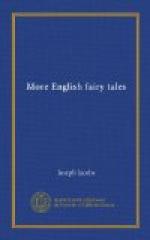Parallels.—The well-known story of the Pied Piper of Hameln (Hamelin), immortalised by Browning, will at once recur to every reader’s mind. Before Browning, it had been told in English in books as well known as Verstegan’s Restitution of Decayed Intelligence, 1605; Howell’s Familiar Letters (see my edition, p. 357, n.); and Wanley’s Wonders of the Little World. Browning is said to have taken it from the last source (Furnivall, Browning Bibliography, 158), though there are touches which seem to me to come from Howell (see my note ad loc.), while it is not impossible he may have come across Elder’s book, which was illustrated by Cruikshank. The Grimms give the legend in their Deutsche Sagen (ed. 1816, 330-33), and in its native land it has given rise to an elaborate poem a la Scheffel by Julius Wolff, which has in its turn been the occasion of an opera by Victor Nessler. Mrs. Gutch, in an interesting study of the myth in Folk-Lore iii., pp. 227-52, quotes a poem, The Sea Piece, published by Dr. Kirkpatrick in 1750, as showing that a similar legend was told of the Cave Hill, Belfast.
Here, as Tradition’s
hoary legend tells,
A blinking Piper once
with magic Spells
And strains beyond a
vulgar Bagpipe’s sounds
Gathered the dancing
Country wide around.
When hither as he drew
the tripping Rear
(Dreadful to think and
difficult to swear!)
The gaping Mountain
yawned from side to side,
A hideous Cavern, darksome,
deep, and wide;
In skipt th’ exulting
Demon, piping loud,
With passive joy succeeded
by the Crowd.
* * * * *
There firm and instant closed
the greedy Womb,
Where wide-born Thousands met a common Tomb.
Remarks.—Mr. Baring-Gould, in his Curious Myths of the Middle Ages, has explained the Pied Piper as a wind myth. Mrs. Gutch is inclined to think there may be a substratum of fact at the root of the legend, basing her conclusions on a pamphlet of Dr. Meinardus, Der historische Kern, which I have not seen. She does not, however, give any well-authenticated historical event at Hameln in the thirteenth century which could have plausibly given rise to the legend, nor can I find any in the Urkundenbuch of Hameln (Luneberg, 1883). The chief question of interest attaching to the English form of the legend as given in 1839 by Elder, is whether it is independent of the German myth. It does not occur in any of the local histories of the Isle of Wight which I have been able to consult of a date previous to Elder’s book—e.g., J. Hassel, Tour of the Isle of Wight, 1790. Mr. Shore, in his History of Hampshire, 1891, p. 185, refers to the legend, but evidently bases his reference on Elder, and so with all the modern references I have seen. Now Elder himself quotes Verstegan in his




